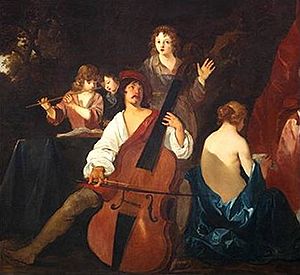Viol facts for kids
The viol (sounds like "mile") is a string instrument played with a bow. It was very popular from the 1400s to the 1700s. Smaller viols are held on your lap, while bigger ones are held between your knees. This is why they were often called "viol da gamba," which means "leg viol."
When you play a viol, you hold the bow with your palm facing upwards. This is different from how violins, violas, or cellos are played today. The viol makes a soft, gentle sound. In the 17th century, when the violin family became popular and people started going to concerts in large halls and operas, viols were used less often. They were never played in orchestras.
Contents
What is a Viol?
Viols are made of wood and look a bit like the violin family. Most viols have six strings, but this number changed over the centuries. The strings were made from animal gut and were not as tight as violin strings.
How Viols Are Made
The fingerboard of a viol has frets, just like a guitar. These frets were also made of gut and were tied around the fingerboard. Players could move them to help tune the instrument. These frets also make it easier for players to find the exact spot to put their fingers. Sometimes, the top parts of the viol were beautifully decorated.
Viols have sloped shoulders and a flat back. The viol, like the vihuela (an instrument it developed from), has a bridge that is flatter than a modern violin's bridge. This flatter bridge makes it easier to play chords (several notes at once). The bow used for a viol was curved outwards (convex), while a violin bow curves inwards (concave).
Different Sizes of Viols
Viols came in many different sizes. Sometimes, a group of viols – maybe four or five instruments – were kept together in a special chest (a large box). This is why they were sometimes called a "chest of viols." When these viols were played together, people called it a "consort of viols." A consort usually had at least one treble (high), tenor (middle), and bass (low) instrument. A "broken consort" meant a mix of different instruments, like viols and recorders. The Lute and bass viol were often played together. Viols were usually tuned in fourths, with one major third in the middle.
Tuning the Viol
The strings of a bass viol (which is similar to a cello in the modern violin family) are tuned from the lowest note upwards to D - G - C - E - A - D. The lowest note is almost two octaves below middle C. The tenor viol was often called a viola da gamba. This was the most popular size for solo music, and many composers wrote sonatas for it. The biggest viol is called the violone. This instrument later developed into the modern double bass. This is why the double bass looks a little different from the violin, viola, and cello. Some double bass players today still hold the bow with their palm facing upwards, just like viol players.
A Look Back: The History of the Viol

The viol was very popular in the homes of wealthy people and at the royal court. During the time of Queen Elizabeth I and later King Charles I, composers like William Byrd, John Dowland, Orlando Gibbons, John Jenkins, and William Lawes wrote music for the viol. Many composers, including Marin Marais, Johann Sebastian Bach, and Karl Friedrich Abel, wrote solo sonatas for the viol. Some of the last and greatest fantasies for viol consort were written by Henry Purcell.
Viols Today
After the mid-18th century, people mostly forgot about the viol. But in the 20th century, there was a new interest in early music. People like Arnold Dolmetsch started making viols again so that Renaissance and Baroque viol music could be played. Today, there are many groups for people who enjoy playing the viol.
One of these groups, The Viola da Gamba Society , has members all over the world. Some modern composers have also written music for the viol, such as John Tavener, Sally Beamish, Thea Musgrave, Tan Dun, and Poul Ruders. There is even a music group called Fretwork that performs viol music.
Images for kids
-
An early Italian tenor viola da gamba, from a painting called St. Cecilia by Raphael, around 1510.
See also
 In Spanish: Viola da gamba para niños
In Spanish: Viola da gamba para niños







